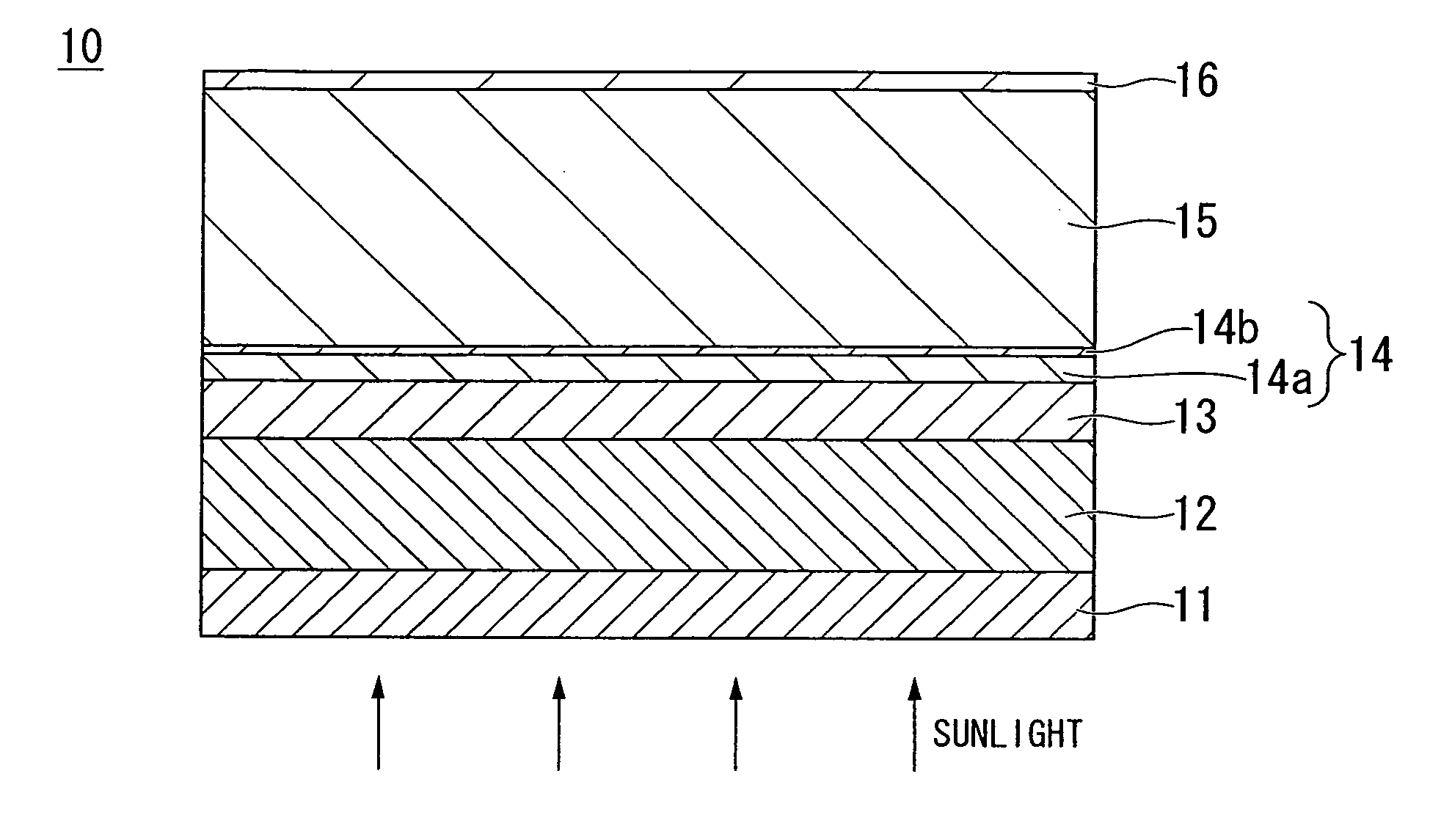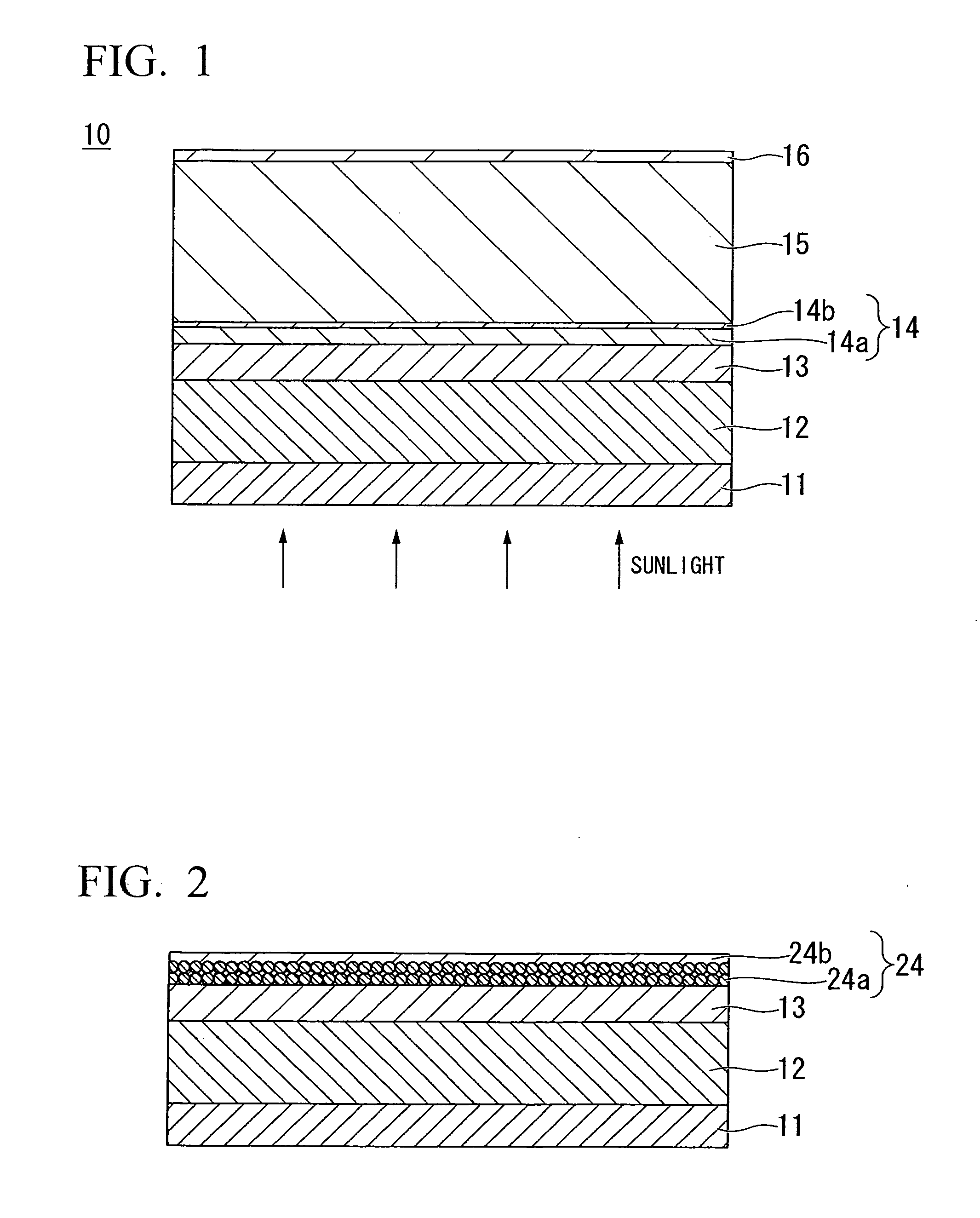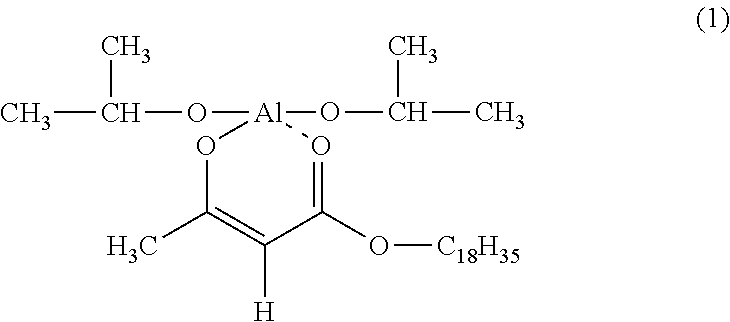Transparent electroconductive film for solar cell, composition for transparent electroconductive film and multi-junction solar cell
- Summary
- Abstract
- Description
- Claims
- Application Information
AI Technical Summary
Benefits of technology
Problems solved by technology
Method used
Image
Examples
example 1
[0090]First, a square piece of glass measuring 10 cm on a side was prepared for the transparent substrate 11, and SnO2 was used for the front side electrode layer 12. The film thickness of the front side electrode layer 12 at this time was 800 nm, the sheet resistance was 10Ω / □, and the haze rate was 15 to 20%. Next, the amorphous silicon layer 13 was deposited onto the front side electrode layer 12 at a thickness of 300 nm using plasma CVD.
[0091]Next, a composition for a transparent electroconductive film composed of an electroconductive fine particle dispersion and a binder dispersion was prepared in the manner described below.
[0092]As shown in Table 1, 1.0 part by weight of ITO powder having an atomic ratio Sn / (Sn+In) of 0.1 and a particle diameter of 0.03 μm was added as electroconductive fine particles, and 0.01 part by weight of the organic titanate coupling agent represented by the aforementioned formula (3) was added as coupling agent followed by the addition of ethanol as d...
example 2
[0101]As shown in Table 1, a multi-junction thin film silicon solar cell was produced and evaluated in the same manner as Example 1 with the exception of using an electroconductive fine particle dispersion obtained by adding 0.5 parts by weight of ITO powder having an atomic ratio Sb / (Sb+In) of 0.05 and a particle diameter of 0.02 μm as electroconductive fine particles and adding 0.01 part by weight of the titanate coupling agent represented by the aforementioned formula (3) as coupling agent followed by adding ethanol as dispersion medium to bring to a total of 100 parts by weight, using a binder dispersion obtained by preparing 0.2 parts by weight of a siloxane polymer as a binder and adding ethanol as a dispersion medium to bring to a total of 100 parts by weight, forming a coated film of electroconductive fine particles by coating the electroconductive fine particle dispersion to a film thickness of the fine particle layer of 20 nm by spin coating, and impregnating the binder di...
example 3
[0102]As shown in Table 1, a multi-junction thin film silicon solar cell was produced and evaluated in the same manner as Example 1 with the exception of using an electroconductive fine particle dispersion obtained by adding 1.0 part by weight of PTO powder (P-doped SnO2) having an atomic ratio P / (P+Sn) of 0.1 and a particle diameter of 0.02 μm as electroconductive fine particles and adding 0.02 parts by weight of the titanate coupling agent represented by the aforementioned formula (2) as coupling agent followed by adding ethanol as dispersion medium to bring to a total of 100 parts by weight, forming a coated film of electroconductive fine particles by coating the electroconductive fine particle dispersion to a film thickness of the fine particle layer of 70 nm by spin coating, and impregnating a binder dispersion onto the coated film of electroconductive fine particles to a film thickness after baking of 70 nm by spin coating. Furthermore, the ratio of fine particles to binder in...
PUM
| Property | Measurement | Unit |
|---|---|---|
| Temperature | aaaaa | aaaaa |
| Percent by mass | aaaaa | aaaaa |
| Thickness | aaaaa | aaaaa |
Abstract
Description
Claims
Application Information
 Login to View More
Login to View More - R&D
- Intellectual Property
- Life Sciences
- Materials
- Tech Scout
- Unparalleled Data Quality
- Higher Quality Content
- 60% Fewer Hallucinations
Browse by: Latest US Patents, China's latest patents, Technical Efficacy Thesaurus, Application Domain, Technology Topic, Popular Technical Reports.
© 2025 PatSnap. All rights reserved.Legal|Privacy policy|Modern Slavery Act Transparency Statement|Sitemap|About US| Contact US: help@patsnap.com



